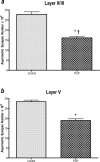Loss of asymmetric spine synapses in dorsolateral prefrontal cortex of cognitively impaired phencyclidine-treated monkeys
- PMID: 21733230
- PMCID: PMC3399728
- DOI: 10.1017/S1461145711000939
Loss of asymmetric spine synapses in dorsolateral prefrontal cortex of cognitively impaired phencyclidine-treated monkeys
Abstract
Schizophrenia patients, long-term abusers of phencyclidine (PCP), and monkeys treated with PCP all exhibit enduring cognitive deficits. Evidence indicates that loss of prefrontal cortex spine synapses results in cognitive dysfunction, suggesting the presence of synaptic pathology in the monkey PCP model; however, there is no direct evidence of such changes. In this study we use the monkey PCP model of schizophrenia to investigate at the ultrastructural level whether remodelling of dorsolateral prefrontal cortex (DLPFC) asymmetric spine synapses occurs following PCP. Subchronic PCP treatment resulted in a decrease in the number of asymmetric spine synapses, which was greater in layer II/III than layer V of DLPFC, compared to vehicle-treated controls. This decrease may contribute to PCP-induced cognitive dysfunction in the non-human primate model and perhaps in schizophrenia. Thus, the synapse loss in the PCP model provides a novel target for the development of potential treatments of cognitive dysfunction in this model and in schizophrenia.
Figures


References
-
- Akil M, Pierri JN, Whitehead RE, Edgar CL, et al. Lamina-specific alterations in the dopamine innervation of the prefrontal cortex in schizophrenic subjects. The American Journal of Psychiatry. 1999;156:1580–1589. - PubMed
-
- Berger B, Gaspar P, Verney C. Dopaminergic innervation of the cerebral cortex: unexpected differences between rodents and primates. Trends in Neurosciences. 1991;14:21–27. - PubMed
-
- Brozoski TJ, Brown RM, Rosvold HE, Goldman PS. Cognitive deficit caused by regional depletion of dopamine in prefrontal cortex of rhesus monkey. Science. 1979;205:929–932. - PubMed
-
- Day M, Wang Z, Ding J, An X, et al. Selective elimination of glutamatergic synapses on striatopallidal neurons in Parkinson disease models. Nature Neuroscience. 2006;9:251–259. - PubMed
Publication types
MeSH terms
Substances
Grants and funding
LinkOut - more resources
Full Text Sources
Medical

